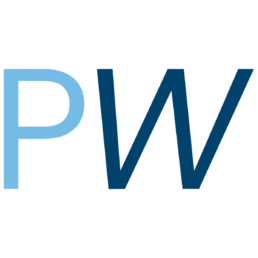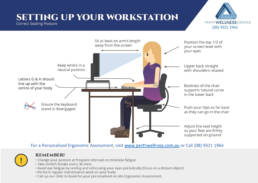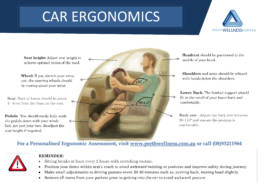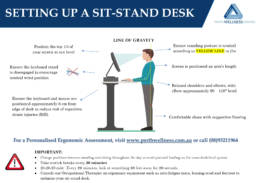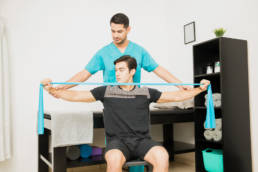Ergonomic Assessment Services
Perth Wellness Centre is the leading provider of allied health services. We are committed to helping you improve your health and overall wellbeing!
Spending the workday tied to your desk can ultimately lead to health challenges. Physical conditions such as cardiovascular health deficits and musculoskeletal conditions have become a serious concern throughout Australia. Office work has been shown to be mentally taxing as well.
To enquire more about our Ergonomic Assessments and Corporate Health, please click here or email us at info@perthwellness.com.
What Are Ergonomic Assessments?
Ergonomics is the study of one’s efficiency in their work environment by measuring what you do, the tools necessary to do your job, and every aspect of your work environment.
Employees tend to miss more time due to workplace injury than any other reason a lot of this is due to musculoskeletal distress caused by not being trained appropriately as to the healthiest ways to do every job. Ergonomic Assessments involve a six-step process.
Step One: Evaluate Office Risk Factors
There are six physical risk factors in the workplace that can have significant effects on the body. These risk factors are:
- Posture
- Repetition
- Forcefulness
- Vibration
- Contact stress
- Task duration
Step Two: Involve and Train Management And Workers
By keeping the employees involved in the assessment process, you can educate both them and management what to watch for, what improves the situation, and what has been done wrong in the past.
Step Three: Collect Evidence
Collect evidence in the form of injury reports, direct observation, medical records and health signs. Interviews with employees will allow us to rank the frequency and the severity of complaints regarding fatigue, stress, and physical discomfort that results from repetitive tasks and postural deficits. This evidence will help us make the changes and recommendations to lower the number of occurrence of these medical issues.
Step Four: Implement Ergonomics Program
Once we have determined where the problems lie, we will be able to recommend those changes that will:
- Eliminate the problems
- Replace various equipment and requirements with more ergonomically correct procedures
- Keep your employees from using equipment and commonplace work items that are causing the most problems
- Changing the way your employees work
- Protect your employees by providing the tools to implement those changes
This part of the evaluation may include workplace massage, physical therapy for those recovering from their injuries, and address any repetitive stress injuries that we have identified.
Step Five: Evaluate Ergonomics Program Effectiveness
Once the new recommendations and training have been in place, we will come in an analyze whether our previously recommended interventions are working. These follow up evaluations will take place one week after implementation and again after one month.
We will look at our previous surveys and interviews and conduct them again with the same employees. By analyzing the previous surveys and comparing them to the new ones, we can see where improvement has taken place and what more might be needed. We will also look at records pertaining to employee absences and injuries and review the indications that there is an improvement in productivity as well.
Step Six: Promote Musculoskeletal Health
Finally, through ongoing health and wellness seminars and training, we will keep your employees aware of the benefits of musculoskeletal health both in the workplace as well as other aspects of their lives. This education will serve to keep your ergonomics program functioning at a level that reduces injury and absenteeism from the workplace.
**Ergonomic Assessments through Telehealth starting from 37.50
Ergonomic Positions
Related Services
Benefits of Ergonomic Assessments
- Evaluates risk factors in the workplace.
- Train workers and managers how to work with less chance for injuries.
- Implements Corporate Health and wellness initiatives.
- Promotes musculoskeletal health.
- Teaches better posture and work habits.
- Evaluates program effectiveness.
